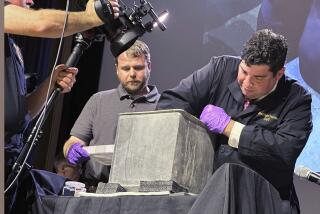Capsule Proves Future Is Unpredictable
- Share via
MIAMI — Thirty-eight years ago, key Florida business executives, military officers and politicians didn’t see the Internet coming. One of them, a federal aviation chief, said commuters would be flying to work in personal aircraft.
This week, making predictions again was proved to be a dicey undertaking, but certainly an interesting one for those on hand to measure forecast against reality.
The prognostications were buried in a time capsule at the front door of the Federal Aviation Administration’s Air Route Traffic Control Center northwest of Miami when it was dedicated June 6, 1962. The capsule was sunk in the ground with plans to open it this year, the first of the new millennium.
The predictions were not completely off the mark--forecasting giant leaps in technology--but many read like science fiction. However, no one predicted the widespread use of home computers and certainly not the Internet.
Air Force Col. Richard R. Stewart foresaw a constant military presence in space aboard manned, orbiting stations and atomic bombs replaced by weapons using “light rays and sound waves.”
Stewart imagined “atomic-powered” aircraft shuttling soldiers and equipment anywhere in the world within minutes, and saw the moon as a “major military base for our space vehicles, securing and exploring the planets beyond.”
NASA’s space shuttle program has flown 100 missions over the past two decades, and is now deeply involved in building an international space station. There haven’t been any manned moon missions since the early 1970s.
Lewis B. Maytag Jr., president of Miami-based National Airlines in 1962, predicted the company would offer supersonic service coast to coast by 2000, with planes moving so rapidly from Miami to Los Angeles that passengers, given time changes, would arrive before they left.
Maytag also forecast his company would introduce “silent jets,” and remain “a corporate entity, undevoured by mergers, the industry leader in aviation.” National Airlines was swallowed in 1980, when Pan American World Airways acquired its routes. Pan American filed for bankruptcy protection in 1991.
Eastern Airlines, which went under in 1989, felt certain it would survive to the turn of the century. The company had 7,500 employees in 1962 and executives predicted that, by now, its planes would fly three times the speed of sound, 60,000 feet high.
Among the more accurate predictions was one from Preston Collins, South Florida manager at Southern Bell Telephone and Telegraph Co. He foresaw the use of communications satellites, the miniaturization of phone components and automated answering systems that would eliminate the work of receptionists.
It was Collins who thought new babies would get a phone number at birth. He said phones would have TV screens and could be used anywhere in the world. Not exactly a cell phone, but not far off either.
In his letter, then-Florida Sen. George Smathers expressed concern over whether the human race would avoid “the holocaust of a nuclear war.”
He also accurately predicted that Florida’s population of 5 million would triple by 2000, but no one foresaw the influx of Latinos and other immigrants, which changed the face of many cities in Florida.
More to Read
Inside the business of entertainment
The Wide Shot brings you news, analysis and insights on everything from streaming wars to production — and what it all means for the future.
You may occasionally receive promotional content from the Los Angeles Times.










